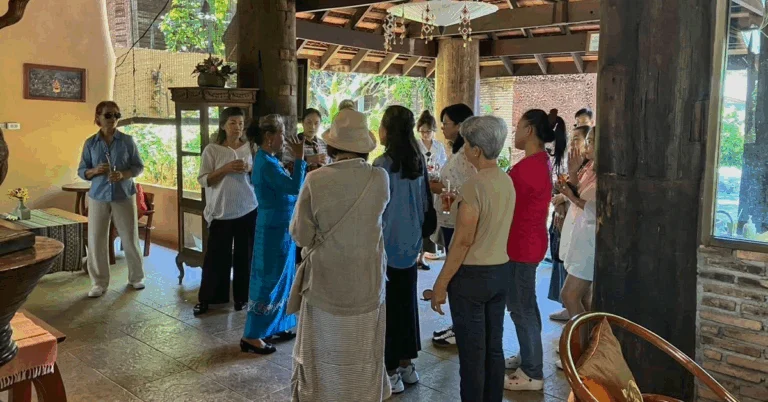Thai article by Assist. Prof. Dr. Chomanaad Boonaree
Thai original: สาวอีสาน(ไม่)รอรัก โดย ผศ.ดร. ชมนาด บุญอารีย์
Translated by Dr. Catherine Churchman
Photo credit: Burst
During the last weeks of 2019, Matichon Weekly and Matichon online published an article by Pensri Pao-leuangtong on the undesirable behaviour of Isan women that sparked a social phenomenon. Expressing the stereotypical value judgements of a middle class woman, the article brought an Isan woman to tears because it used without her permission a photo of her dark-skinned self together with her pale-skinned French husband (Kom Chad Luek, 2019). Pichet Saengthong (2019) expressed the view that this article was “filled with prejudice as well as myths…
It seems as if Pensri has come up with the idea of “Mia Farang” (women who have married Westerners) in Isan society using her middle class world view as the criterion with which to judge the actions of Isan women. Pensri has written of the dignity of a being a woman and the dignity of being human, and how neither should ever be reduced down to the level of being purchasable commodities. This is an evaluation of village women in Isan society according to middle class morality, however within Isan society itself there exists an alternative conception of dignity, namely a dignity based on the ability to support parents and raise children which is considered more desirable. Of course, this inevitably clashes with the morality of middle class women like Pensri, and therefore leads her to judge it as something pitiable and shameful. Pensri’s judgment is characterised by its universalist stereotyping.”
A strong open expression of disdain for 11 Million Isan women in a country with a female population of 33 Million (National Statistical Office, 2019) makes me resentful as an Isan woman, but as an academic from the faculty in which this topic has been the object of serious study for over two decades (Faculty of Humanities and Social Sciences at Khon Kaen University: KKU) it also arouses my interest.
One of the faculty members, Assistant Professor Dr. Patcharin Lapanun has researched this topic and provided fresh perspectives that have been recognized to be internationally significant. Her PhD thesis in Anthropology at Vrije Universiteit Amsterdam was recently published by the National University of Singapore Press under the title Love, Money and Obligation: Transnational Marriage in a Northeastern Thai Village (2019).
The online version of Pensri’s article was deleted in two days after receiving numerous negative reactions from readers. Then Matichon PCL posted an apology for publishing it and ended Pensri’s column. However, comments in video and in written form sprang up in many different places, such as Prachatai, The Matters, The Isan Record, and Workpointnews. These offered up a whole range of research on the topic, and therefore I don’t wish to discuss here the reasons behind Isan women marrying westerners or whether or not they are happy in marriage afterwards.
The question I want to ask of our society is: How was it that we ended up like this in the first place, and where should wme go from here?
The main issue is not just that Bangkok people earn nine times the average income of people in Isan (Thai Rath Online, 2019) but also that these people still remain far from any understanding of their female Isan compatriots. This I say as an educated Isan woman who has witnessed the way Isan people (including me) are perceived by those from central Thailand, both after I had left Ubon for Bangkok to study at Thammasat University and during my doctoral study in a few years ago in New Zealand.
Personally, I ponder issues such as exactly what it is that leads people from other regions, particularly those from Bangkok, to have disdain for Isan people. Was it the cracked soil of Isan in an advertisement from thirty years ago? Maybe it was increased by that song about the Isan woman “Waiting for Love” that emphasised her inferiority. Was that it, perhaps?
Then I think back to that story in Suwanni Sukhontha’s “Suan Sat (The Zoo)” about her mother from the north who 90 years ago, was despised as a “Lao” by people in a central Thai village for growing her hair long, wearing a sinh, and eating glutinous rice; descendants of the ancient Lao empires, whether Lanna (Northern Thailand now) or Lanxang (Northeastern Thailand now), were viewed as utterly low class in Thai society. (Comments from the author – however, nowadays Lanna people, who are more favored due to their fair skin color has successfully revitalized and commercialised their Lanna culture. So the disdain of people from the north differs from the Isan case.)
Looking at the academic research on the origins of the low status of Isan people, I wrote in my thesis that “it appears that the supremacy of the culture of the capital, and the continued discrimination against Isan people is a deeply rooted norm in the minds of all Thai people, Isan and non-Isan alike.” A decade ago Myers’ (2005) study on Isan identity during 1964–2004 revealed the identity experiences of a 30 year-old educated Isan man (born in 1975) who migrated to live as a professional in Australia. Even though his parents were teachers, and middle class in Isan society, the participant highlighted the characteristic propensity of Isan people to surrender to the culture of the capital: “I had always been taught that the Bangkokian disdain for Isan people is acceptable, that the Thai cultural superiority is a norm, and that Isan people will never reach the status of economic prosperity and social acceptance if they retain their Isanian identities” (Myers, 2005 p66).
I studied the background to the oppression and discrimination faced by the people of the Isan region in Charles S. Keyes’ works (2003; 2014). Keyes asserted that the introduction of primary schools in 1934, which were inappropriate to traditional Isan village life, marked “the Thai frame of reference” of national consciousness and loyalty for these isolated minority villagers (Keyes, 2014, p. 63). Educational reforms together with centralised administrative reforms and transport reforms enabled Isan people to travel to the capital city, causing them to come to realise that their future was governed by decisions made in Bangkok. Most importantly, these modern innovations “began to make northeasterners realise that their local culture and patterns of living were considered inferior to those of central Thai” (Keyes, 2014, p. 63). While resistance to central Thai power was evident from the 1920’s, mixed feelings and an ambivalent attitude toward their own Isan culture have gradually increased because of the superior attitudes of government representatives from the central region.
Over a century has passed since the integration of regions into modern Siam under King Rama V, this, coupled with the rise of elite nationalism, the prevention of the expansion of the Communist Party, and development policies and capitalist industrialization after 1960 combined to push millions of Isan people into becoming temporary migrant workers in Bangkok (Keyes, 2014; Wyatt, 1969; Myers 2005) Over the last five decades, Isan people have struggled to seek economic opportunities and have become “the formally-recognized labour class of Thailand” (Myers p. vi), and in consequence the Isan people still hold a low social status, and continue to struggle with their own identity. Rural Isan people are likely influenced both by oppression from officials in their home villages and by Bangkok city dwellers’ views of them as provincial hicks.
I would like to use this opportunity to publicly express an Isan woman’s point of view, that a substantial number of Isan people are fighters, determined to do whatever they can to raise their status in society. There is no truth whatsoever in saying that Isan women are uninterested in education and content to be purchased as commodities or lack any kind of dignity. You can read or watch more about the life opportunities in this extremely unequal country of ours in the critiques of the “Heartbound” (such as The World of “Mia Farang”: on the omission of Isan men in a society with no future by Wajjana Walayangkul).
There are many Isan families who have succeeded in the struggle against poverty but many have not. I have witnessed the determination in those men and women of my grandparents’ generation on both sides of my rural Isan family to use education as a ladder by which they could climb out of poverty, and their migration over the last century from villages into the cities.
Additionally, through conducting interviews for my doctoral research, I observed many Isan people who for one reason or another had lacked opportunities for education, and yet continued to strive for it through informal means. With this truth in mind, when people from other countries ask about Thai women’s involvement in sex work, I usually answer that if my ancestors had not been very progressive who sent all of their children to school almost a century ago (my aunt used to ride a horse to school over ninety years ago) I myself would now lead an excruciating life and would probably have go to live and work in Pattaya or Phuket as well. Opportunities are simply not equal, especially for those who have divorced, and other articles have mentioned this already.
If becoming ever more inclusive is the way of the world at present, it is useless to persist in dividing people up when a diverse world is coming. “TCDC Global Trends 2020” (TCDC, 2019) indicates that within the next 20 years, intercultural marriages will multiply to the point that whites become a minority in the United States and Europe. In Thailand intercultural marriages are also on the increase, due to the gender imbalance caused by the continual increase of the population of Thai women beyond that of Thai men since 1960, resulting in women in Thailand outnumbering men by over 1.3 million people (PPTV Online, 2018).
The Isan woman of today, whether rich or poor, no longer has to “wait for love”. She possesses personal characteristics that directly align with what Westerners look for. The fact that she has the dark skin for which Thai culture has a deep-rooted cultural dislike (Purnell, 2013) and is a fighter, actually turn out to provide her with the right to decide her own destiny, be this raising a family, studying, migrating to another region or working abroad. She does not need to choose to live as an “Isan woman waiting for love” who sits and waits for the affections of a Thai man who dislikes her appearance and constantly insults her ethnicity.
Where to go from here? If we wish to build a harmonious society, we Thais need to alter some of the ingrained ways of thinking from the past century. If we do not change, within twenty years when almost every Thai family from every class has children who marry people from one or another country, how are we going refer to these ladies? “Singaporean wife”? “Japanese wife”? “Chinese wife”? “Korean wife”? “Israeli wife”? That would just be silly.
How will we learn for the future? Can we do a few things with education, for example teaching about empathy and compassion as is done in Denmark? (Menezes, 2019)
We can admit that if an Isan woman looked different and had different abilities, for instance holding an MA degree or looking like one of the singers from Blackpink, we would not dare judge her, no matter whether she chose to either Kill This Love, Save This Marriage or marry any man in the world she felt like. A woman’s own decision whether to marry or not, or to choose a partner or otherwise is her own right, and it is this that I consider to be the dignity of being human. As long as a woman has chosen herself and hasn’t been forced into it, there is no reason at all to regard marriage to a Westerner as anything undignified.
The final question that we middle class people ought to ask ourselves is: If we didn’t have much in the way of education, had looks that didn’t accord with Thai men’s preferences, and if we lived in a society in which there was no future for us how would we behave? If we lived in a society that spoke a different language, and in which we were limited in our choice of work, and if romantic feeling was not a major factor in our lives, would we then be daring enough to step out of our comfort zones, and with those limited capabilities, would we dare to marry into and go to live within a different culture, in order to fight to improve our own lives, and that of others?
References
Keyes, C. F. (2003). The politics of language in Thailand and Laos. In M. Brown & S. Ganguly (Eds.), Fighting words: Language policy and ethnic relations in Asia (pp. 177–210). Cambridge, MA: MIT Press.
——–. (2014). Finding their voice: Northeastern villagers and the Thai state. Chiang Mai, Thailand: Silkworm Books.
Kom Chad Leuk. (2019). The girl was stolen by a famous writer to compose an article stretching to Isan women. Retrieved from https://www.komchadluek.net/news/hotclip/406720
Menezes, F. (2019). In Denmark, empathy classes are part of the National Curriculum. Retrieved from https://brightvibes.com/1556/en/in-denmark-empathy-classes-are-part-of-the-national-curriculum?fbclid=IwAR3dwnG-SfxI_3jHjsdNISAPKlt8nRVLQprN-jLFcdN2MtTXiZQ5mLRTSog
Myers, R. L. (2005). The Isan Saga: The inhabitants of rural Northeast Thailand and their struggle for identity, equality and acceptance (1964–2004). (Master of Arts in Asian Studies, San Diego State University, USA).
National Statistical Office. (2019). Mid-year population by gender, region and province (from the Ministry of Public Health) 2009 – 2018. Retrieved from http://statbbi.nso.go.th/staticreport/page/sector/th/01.aspx
PPTV Online. (2561). Fewer marriage opportunities for Thai women due to the gender imbalance by 1.29 million. Retrieved from https://www.pptvhd36.com/news/%E0%B8% 9B%E0 %B8%A3%E0%B8%B0%E0%B9%80%E0%B8%94%E0%B9%87%E0%B8%99%E0%B8%A3%E0%B9%89%E0% B8%AD%E0%B8%99/76591
Purnell, N. (2013). Images spark racism debate in Thailand. Retrieved from https://www.newyorker.com/business/currency/images-spark-racism-debate-in-thailand
Saengthong. P (2019). Pensri Pao-leuangtong’ case and the last breath of columnist in the “old media” culture. Retrieved from https://mgronline.com/south/detail/9620000122857
TCDC (2019). TCDC Global Trends 2020: Positive Power. Retrieved from https://web.tcdc.or.th/th/Publication/Detail/Trend2020-Positive-Power
Thai Rath Online. (2019). Bank of Thailand reports the extreme inequality in Thailand until – 10.3 times apart. Retrieved from https://www.thairath.co.th/news/business/1723501
Wyatt, D. K. (1969). The politics of reform in Thailand: Education in the Reign of King Chulalongkorn. New Haven: Yale University Press.
บทความภาษาไทย
อาจารย์มหาวิทยาลัยขอนแก่นทนไม่ไหว เขียนบทความตอบโต้คอลัมนิสต์ชื่อดังมติชนสุดสัปดาห์หลังจากเขียนบทความดูถูกสาวอีสาน ระบุสาวอีสานไม่รอรัก แต่ทุกอย่างต้องดิ้นรนไขว่คว้าเพราะโอกาสของคนไม่เท่ากัน
บทความ – สาวอีสาน (ไม่) รอรัก
โดย – ผศ.ดร. ชมนาด บุญอารีย์ นักวิชาการมหาวิทยาลัยขอนแก่น (มข.)
หมายเหตุ ทัศนะและเนื้อหาที่ปรากฏในวารสารเป็นทัศนะส่วนบุคคลของผู้เขียน ไม่ถือเป็นทัศนะและความรับผิดชอบของต้นสังกัด
ช่วงสัปดาห์สุดท้ายของปี พ.ศ. 2562 ที่ผ่านมามีเหตุการณ์เชิงสังคมที่เกิดขึ้นบนโลกออนไลน์ คือ บทความเกี่ยวกับนิสัยของผู้หญิงอีสาน ซึ่งมีเสียงตอบรับทั้งน้ำตาจากผู้หญิงอีสานที่ถูกนำรูปเธอซึ่งมีผิวคล้ำกับสามีผิวขาวชาวฝรั่งเศสมาประกอบบทความโดยไม่ได้รับอนุญาต (คมชัดลึก, 2562) และผู้ชาย (พิเชฐ แสงทอง, 2562) ซึ่งแสดงทัศนะไว้ว่า
“…จะพบ “อคติ” ตลอดจน “มายาคติ” ต่างๆ เต็มไปหมดทั้งชิ้น ราวกับคุณเพ็ญศรีผู้เขียนบทความนั่งมโนถึงวัฒนธรรมเมียฝรั่งในชุมชนอีสาน ผ่านมุมมองหรือโลกทัศน์แบบชนชั้นกลางของคุณเพ็ญศรีเอง และใช้เกณฑ์ประเมินค่าจากจุดยืนดังกล่าวเป็นเกณฑ์การตัดสินการกระทำของผู้หญิงอีสาน คุณเพ็ญศรีพูดถึงศักดิ์ศรีของความเป็นผู้หญิง ศักดิ์ศรีของความเป็นมนุษย์ที่จะไม่ลดตัวลงไปเป็นสินค้า ซึ่งก็เป็นคติแบบชนชั้นกลาง นำมาสอดส่องประเมินค่าผู้หญิงชาวบ้านในสังคมอีสาน ที่ย่อมมีวิธีคิดเกี่ยวกับศักดิ์ศรีอีกแบบหนึ่ง นั่นก็คือ ความสามารถที่ตนเองเลี้ยงดูพ่อแม่ลูกหลานได้ ย่อมแสดงถึงศักดิ์ศรีที่น่าปรารถนากว่า ซึ่งแน่นอนว่าศักดิ์ศรีแบบนี้ย่อมเป็น “ปฏิปักษ์” กับศักดิ์ศรีของผู้หญิงชนชั้นกลางแบบคุณเพ็ญศรี คุณเพ็ญศรีจึงตัดสินว่านั่นเป็นสิ่งที่น่าเศร้าและน่าละอาย ลักษณะการประเมินค่าของคุณเพ็ญศรีจึงมีลักษณะเหมารวม…”
เหตุการณ์ที่แสดงทัศนคติเชิงลบอย่างชัดแจ้งต่อผู้หญิงอีสาน 11 ล้านคน ในประเทศที่มีประชากรหญิง 33 ล้านคน (สำนักงานสถิติแห่งชาติ, 2562) เป็นเรื่องที่น่าขัดเคืองใจสำหรับดิฉันในฐานะผู้หญิงอีสาน และน่าสนใจในฐานะนักวิชาการในคณะที่มีการศึกษาเรื่องนี้อย่างจริงจังมาเป็นเวลากว่า 20 ปี (คณะมนุษยศาสตร์และสังคมศาสตร์ มหาวิทยาลัยขอนแก่น) ล่าสุดดุษฎีนิพนธ์ของ ผศ.ดร. พัชรินทร์ ลาภานันท์ (สาขา Anthropology จาก Vrije University Amsterdam) ที่ศึกษาเรื่องนี้และให้มุมมองใหม่ๆ ซึ่งมีคุณค่าในระดับนานาชาติในจนได้รับการจัดพิมพ์โดย National University of Singapore Press ในชื่อ Love, Money and Obligation: Transnational Marriage in a Northeastern Thai Village (2019)
หลังบทความที่แสดงวิธีคิดเชิงคุณค่าแบบเหมารวมของหญิงชนชั้นกลางออกมา ก็มีคลิปและบทความจากหลายแหล่ง เช่น ประชาไท, The Matters, The Isaan Record และ Workpointnews ที่นำเสนองานวิจัยต่างๆ ที่มองอย่างรอบด้านขึ้น ในที่นี้ ดิฉันจะไม่กล่าวถึงว่า ทำไมสาวอีสานจึงแต่งงานกับฝรั่ง แต่งแล้วดีหรือไม่อย่างไร แต่อยากถามสังคมว่า เรามาถึงจุดนี้กันได้อย่างไร และจากจุดนี้ เราจะไปไหนกันดี
จุดนี้คือจุดที่เราไม่ได้เพียงห่างกันด้วยความเหลื่อมล้ำ 9 เท่าของรายได้เฉลี่ยของคนกรุงกับคนอีสาน (ไทยรัฐออนไลน์, 2562) แต่ยังห่างไกลจากความเข้าใจเพื่อนร่วมชาติซึ่งเป็นหญิงอีสานจำนวนไม่น้อย ที่ดิฉันพูดได้อย่างนี้ เพราะแค่เป็นคนอีสานที่มีการศึกษา (ยังไม่ได้เป็นเมียฝรั่ง) ยังเคยพบทัศนะคติเหยียดคนอีสานจากคนไทยภาคกลาง ทั้งเมื่อตอนที่จากอุบลราชธานีบ้านเกิดเข้ากรุงฯ มาเรียนที่มหาวิทยาลัยธรรมศาสตร์เมื่อปี พ.ศ. 2536 จนไปเรียนปริญญาเอกที่ประเทศนิวซีแลนด์เมื่อไม่กี่ปีมานี้
มีสองสามสิ่งที่ดิฉันพยามอธิบายกับตนเองว่า ทำไมคนภาคอื่นโดยเฉพาะคนกรุงเทพฯ ถึงดูถูกคนอีสาน ภาพดินแตกระแหงของอีสานในโฆษณาเมื่อ 30 ปีที่แล้วก็คงมีส่วน เพลงสาวอีสานรอรักยิ่งตอกย้ำความต้อยต่ำงั้นหรือ ดิฉันยังนึกย้อนไปถึงงานเขียนเรื่อง สวนสัตว์ ของสุวรรณี สุคนธา ที่กล่าวถึงมารดาว่าเป็นคนเหนือและถูกรังเกียจจากคนภาคกลางซึ่งไม่ไว้ผมยาว นุ่งผ้าซิ่น และกินข้าวเหนียว ว่า “เป็นลาว” ดังนั้น ไม่ว่าลาวล้านนาหรือล้านช้างก็ดูจะโลโซทั้งสิ้น
ถ้าจะดูจากงานวิชาการซึ่งอธิบายถึงที่มาของความต่ำต้อยของคนอีสาน ความยิ่งใหญ่ของวัฒนธรรมเมืองหลวงของกรุงเทพฯ และการเลือกปฏิบัติต่อชาวอีสานนั้นฝังรากลึกในความคิดของคนไทยซึ่งเป็นบรรทัดฐาน สำหรับทั้งคนอีสานและคนที่ไม่ใช่ชาวอีสาน Myers (2005) ศึกษาเกี่ยวกับประสบการณ์ซึ่งหล่อหลอมอัตลักษณ์ของชาวอีสานในช่วงปี พ.ศ. 2507-2547 เขายกตัวอย่างประสบการณ์ของชายชาวอีสานที่เป็นคนมีการศึกษา ที่แม้ปัจจุบันเขาจะอพยพไปทำงานและอาศัยอยู่ในประเทศออสเตรเลีย และแม้ว่าบิดามารดาของเขาจะเป็นครูซึ่งเป็นชนชั้นกลางในสังคมชนบทอีสานที่เขาเกิดมา เขาก็ได้เน้นถึงลักษณะที่คนอีสานยอมสยบต่อคนและวัฒนธรรมเมืองหลวงของกรุงเทพฯ ดังนี้
“ผมได้รับการสอนเสมอว่าการที่คนกรุงเทพฯ จะรังเกียจคนอีสานเป็นเรื่องที่ยอมรับได้ว่าวัฒนธรรมชั้นสูงของคนไทย (ภาคกลาง) นั้นเป็นบรรทัดฐานของสังคม และคนอีสานจะไม่มีวันได้รับการยอมรับว่าร่ำรวยมั่งคั่งและได้การยอมรับทางสังคมหากพวกเขายังคงเอกลักษณ์อีสาน (Myers, 2005 น. 66)” (I had always been taught that the Bangkokian disdain for Isan people is acceptable, that the Thai cultural superiority is a norm, and that Isan people will never reach the status of economic prosperity and social acceptance if they retain their Isanian identities (Myers, 2005, p. 66).
ที่มาที่ไปของการกดและเหยียดคนอีสาน หาอ่านได้จากงานของ Keyes (2003; 2014)
เขายืนยันว่าการเปิดโรงเรียนประถมศึกษาในปี พ.ศ. 2440 ซึ่งไม่เหมาะสมกับวิถีชีวิตของชาวอีสานดั้งเดิมนั้น ได้สร้าง “กรอบอ้างอิงของคนไทย” เพื่อให้ชาวบ้านที่อาศัยในดินแดนอีสานที่แยกตัวห่างไกลจากเมืองหลวงมีจิตสำนึกแห่ง “ชาติ” และความภักดีต่อชาติไทย การปฏิรูปการศึกษาร่วมกับการปฏิรูปการปกครองแบบรวมศูนย์และการปฏิรูปการขนส่งทำให้ชาวอีสานเดินทางไปยังเมืองหลวงได้ง่ายขึ้น และทำให้พวกเขาตระหนักว่าอนาคตของพวกเขาอยู่ภายใต้การตัดสินใจของกรุงเทพฯ สิ่งสำคัญที่สุดคือ
นวัตกรรมสมัยใหม่เหล่านี้ “เริ่มทำให้ชาวอีสานตระหนักว่าวัฒนธรรมท้องถิ่นและรูปแบบการใช้ชีวิตของพวกเขานั้นด้อยกว่าของคนไทยภาคกลาง” (Keyes, 2014, น. 63) ในขณะที่การต่อต้านอำนาจจากส่วนกลางของไทยนั้นชัดเจนจากยุค 1920 (กบฏผีบุญ) แต่ความรู้สึกที่ผสมปนเปกันและทัศนคติที่สับสนต่อวัฒนธรรมอีสานของพวกเขาเองก็ค่อยๆ เพิ่มขึ้นเนื่องจากทัศนคติของ “ผู้เหนือกว่า” ซึ่งเป็นตัวแทนจากรัฐไทยจากภาคกลาง
ในเชิงประวัติศาสตร์ 100 กว่าปีที่ผ่านมาตั้งแต่สมัยรัชกาลที่ 5 นับแต่การบูรณาการภูมิภาคต่างๆ เข้ากับสยามสมัยใหม่ การเพิ่มขึ้นของชาตินิยมชนชั้นสูง (elite nationalism) การป้องกันการขยายตัวของพรรคคอมมิวนิสต์ นโยบายการพัฒนา และการพัฒนาอุตสาหกรรมทุนนิยมหลังจากปี 1960 เป็นเหตุที่ผลักดันให้ชาวอีสานหลายล้านคนกลายเป็นแรงงานอพยพชั่วคราวในกรุงเทพฯ (Keyes, 2014; Wyatt, 1969)
ความรู้สึกที่ด้อยกว่าของชาวอีสานในชนบทมักเกิด จากการกดขี่โดยเจ้าหน้าที่ไทยในบ้านเกิดของพวกเขาและทัศนคติของคนกรุงเทพฯ ในเมืองที่มองว่าพวกเขาเป็นพวกคนต่างจังหวัด ชาวอีสานมักเรียกตัวเองอย่างถ่อมตนว่าเป็น “ชาวบ้าน” และเรียกผู้มีอำนาจหรือมีการศึกษาสูงกว่าว่า “เจ้านาย” (Keyes, 2014, น. 110)
นอกจากนี้ Myers (2005) ระบุด้วยว่า50 ปีที่ผ่านมาคนอีสานได้ดิ้นรนเพื่อแสวงหาโอกาสทางเศรษฐกิจและกลายเป็น “ชนชั้นแรงงานที่ได้รับการยอมรับอย่างเป็นทางการของประเทศไทย” (น. vi) ดังนั้นสถานะทางสังคมของคนอีสานจึงยังคงอยู่ในระดับต่ำและความท้าทายในการยอมรับตัวตนจะดำเนินต่อไป
ดิฉันอยากใช้โอกาสที่เกิดการแสดงทัศนะเหยียดคนอีสานอย่างเป็นลายลักษณ์อักษรในสื่อสาธารณะแสดงทัศนะของผู้หญิงอีสานคนหนึ่งว่า คนอีสานจำนวนมากนั้นเป็นนักสู้และมุ่งมั่นดิ้นรนทุกวิถีทาง เพื่อยกสถานภาพในสังคม การเหมารวมว่า ผู้หญิงอีสานไม่ตั้งใจเล่าเรียนและสบายใจที่ทำตัวเป็นสินค้าอย่างไร้ศักดิ์ศรีนั้นไม่จริงอย่างยิ่ง โอกาสของชีวิตในประเทศที่มีความเหลื่อมล้ำสูงแห่งนี้ไม่เท่ากัน สามารถหาดูหรืออ่านเพิ่มเติมจากคำวิจารณ์เรื่อง Heartbound ได้ (เช่น โลกของ ‘เมียฝรั่ง’ เรื่องเล่าที่ไม่มีผู้ชายอีสาน ในสังคมที่ไม่มีอนาคต ของวรรจนา วัลยางกูล)
มีครอบครัวอีสานจำนวนไม่น้อยที่ต่อสู้กับความยากจนได้สำเร็จและจำนวนมากไม่สำเร็จ ในช่วงเวลา 100 ปีที่ผ่านมาในครอบครัวชาวนาอีสานของทั้งฝ่ายพ่อและแม่ของดิฉัน ดิฉันได้เห็นความมุ่งมั่นดิ้นรนตั้งแต่รุ่นปู่ย่าตายายและของทั้งผู้หญิงและผู้ชายในการใช้การศึกษาเป็นบันไดเพื่อปีนหนีจากความยากจนและออกจากหมู่บ้านเข้ามาอยู่ในเมือง
นอกจากนี้ ในการไปสัมภาษณ์เพื่อทำวิจัยระดับปริญญาเอก ดิฉันก็ได้เห็นคนอีสานหลายคนที่ขาดโอกาสในการเรียนไปด้วยเหตุต่างๆ และต่อมาขวนขวายเรียน กศน. ดังนั้น เมื่อมีชาวต่างชาติถามเกี่ยวกับผู้หญิงหากินเมืองไทย ดิฉันจึงมักตอบว่า ถ้าบรรพบุรุษไม่หัวก้าวหน้ามากจนส่งลูกสาวทุกคนไปโรงเรียนเมื่อเกือบร้อยปีก่อน (คุณป้าขี่ม้าไปเรียนหนังสือเมื่อ 90 ปีก่อน) และมานะพากเพียรแบบเลือดตาแทบกระเด็น ตอนนี้ดิฉันก็อาจจะไปทำงานที่พัทยาหรือภูเก็ตก็ได้ โอกาสคนเราไม่เท่ากัน โดยเฉพาะคนที่หย่าร้างซึ่งบทความอื่นๆ ได้กล่าวถึงอย่างชัดเจนไปแล้ว
หากจะหมุนให้ทันโลก inclusiveness หรือการนับรวม/คำนึงถึงคนทุกกลุ่มในสังคม คือคำตอบของโลกยุคนี้ ไม่มีประโยชน์ที่จะมามัวแยกเขาแยกเราในโลกอนาคตที่จะหมุนไปด้วยความแตกต่างหลากหลาย
“เจาะเทรนด์โลก 2020” โดย TCDC (2562) ระบุว่า ในอนาคตอันใกล้ คืออีกเพียง 20 ปีข้างหน้า ในปี ค.ศ.2040 การแต่งงานข้ามเชื้อชาติจะเพิ่มทวีจนคนผิวขาวจะกลายเป็นคนกลุ่มน้อยทั้งในสหรัฐอเมริกาและในยุโรป ในประเทศไทยเองการแต่งงานข้ามเชื้อชาติก็มีความเป็นไปได้สูงขึ้นเนื่องจากจำนวนหญิงไทยได้เพิ่มมากขึ้นกว่าประชากรชายอย่างต่อเนื่องตั้งแต่ ปี 2503 จนในปี 2561 ประชากรหญิงไทยมีมากกว่าประชากรชายถึง 1.3 ล้านคน (PPTV Online, 2561)
สาวอีสานทั้งจนรวยยุคนี้ไม่ได้รอรัก แต่มีบุคลิกลักษณะที่ตรงกับความต้องการของชาวต่างชาติ ผิวคล้ำที่ถูกมองว่าไม่ดีอย่างฝังรากลึกในวัฒนธรรมไทย (Purnell, 2013) และความเป็นนักสู้อาจทำให้เธอมีสิทธิ์เลือกกำหนดชะตาชีวิตตนเองไม่ว่าจะสร้างครอบครัว เรียน อพยพย้ายถิ่น หรือทำงานในต่างประเทศ มากกว่าเป็น “สาวอีสานรอรัก” ที่นั่งรอความรักจากชายไทยที่ไม่ชอบรูปลักษณ์และดูถูกชาติพันธุ์ของเธออย่างห่อเหี่ยวไปวันๆ
จากจุดนี้ เราจะไปไหนกัน? หากจะสร้างสังคมสมานฉันท์ คนไทยควรปรับความคิดที่ฝังมาเป็นร้อยปี หากไม่ปรับวันนี้ ภายใน 20 ปี เมื่อเกือบทุกครอบครัวไทยไม่ว่าจะชนชั้นไหนมีลูกหลานสมรสกับชาวต่างชาติไม่ชาติใดก็ชาติหนึ่ง ถึงเวลานั้นเราจะเรียกสุภาพสตรีเหล่านั้นว่าอย่างไร เมียสิงคโปร์ เมียญี่ปุ่น เมียจีน เมียเกาหลี เมียอิสราเอล คงวุ่นวายพิลึก
จากจุดนี้ เราเรียนรู้อะไร? เราทำบางอย่างในระบบการศึกษาได้ไหม เช่น สอนเกี่ยวกับความเห็นอกเห็นใจกันในชั้นเรียนตั้งแต่อายุ 6 ถึง 16 ปี เหมือนในประเทศเดนมาร์ก (Menezes, 2019)
ในวันนี้ หากภาพลักษณ์ของผู้หญิงอีสานเป็นอีกรูปร่างและความสามารถ เช่น เรียนจบปริญญาโท หรือขั้นสุด คือ สวยมากความสามารถแบบนักร้องสาววง Blackpink เราคงต้องยอมรับว่า เราจะไม่บังอาจตัดสินเธอ ไม่ว่าเธอจะเลือก Kill This Love, Save This Marriage หรือแต่งงานกับผู้ชายคนไหนบนโลกใบนี้ การที่ผู้หญิงได้ตัดสินใจเองว่าจะแต่งงานหรือไม่แต่ง หรือเลือกแต่งกับใครหรือไม่แต่งกับใคร เป็นสิทธิของผู้หญิงและถือเป็นศักดิ์ศรีของความเป็นมนุษย์ การแต่งงานกับชาวต่างชาติถ้าผู้หญิงเลือกเองไม่ได้ถูกบังคับ ถือว่ามีศักดิ์ศรี
คำถามท้ายสุดสำหรับคนชั้นกลาง เราควรถามตัวเองว่า หากเรามีการศึกษาน้อยนิด มีรูปร่างหน้าตาที่ไม่ใช่สเปคหนุ่มไทย อยู่ในสังคมที่ไม่มีอนาคตสำหรับเรา พูดภาษาอื่นได้อย่างจำกัด เลือกงานไม่ได้ และไม่ได้ใช้ความรักเป็นปัจจัยหลักของชีวิต เราจะกล้าออกจาก comfort zone ด้วยต้นทุนชีวิตอันน้อยนิด แล้วยังกล้าพอที่จะแต่งงานไปอยู่ในวัฒนธรรมอื่นและต่อสู้ชีวิตเพื่อประโยชน์ของตนเองและคนข้างหลังหรือไม่?
——
รายการอ้างอิง
คมชัดลึก. (2562). สาวถูกนักเขียนดังขโมยภาพไปประกอบบทความเหยียดผู้หญิงอีสาน. ค้นข้อมูล https://www.komchadluek.net/news/hotclip/406720
ไทยรัฐออนไลน์. (2562). ธนาคารแห่งประเทศไทยเปิดผลศึกษา “ความเหลื่อมล้ำ” ของไทย จน-รวย ห่างกัน 10.3 เท่า. ค้นข้อมูล https://www.thairath.co.th/news/business/1723501
พิเชฐ แสงทอง. (2562). กรณี “เพ็ญศรี เผ่าเหลืองทอง” กับเฮือกสุดท้ายของคอลัมนิสต์ในวัฒนธรรม “สื่อเก่า”. ค้นข้อมูลhttps://mgronline.com/south/detail/9620000122857
สำนักงานสถิติแห่งชาติ. (2562). จำนวนประชากรกลางปี จำแนกตามเพศ ภาค และจังหวัด (จากกระทรวงสาธารณสุข) พ.ศ. 2552 – 2561. ค้นข้อมูล http://statbbi.nso.go.th/staticreport/page/sector/th/01.aspx
Keyes, C. F. (2003). The politics of language in Thailand and Laos. In M. Brown & S. Ganguly (Eds.), Fighting words: Language policy and ethnic relations in Asia (pp. 177–210). Cambridge, MA: MIT Press.
——–. (2014). Finding their voice: Northeastern villagers and the Thai state. Chiang Mai, Thailand: Silkworm Books.
Menezes, F. (2019). In Denmark, empathy classes are part of the National Curriculum. Retrieved from https://brightvibes.com/1556/en/in-denmark-empathy-classes-are-part-of-the-national-curriculum?fbclid=IwAR3dwnG-SfxI_3jHjsdNISAPKlt8nRVLQprN-jLFcdN2MtTXiZQ5mLRTSog
Myers, R. L. (2005). The Isan Saga: The inhabitants of rural Northeast Thailand and their struggle for identity, equality and acceptance (1964–2004). (Master of Arts in Asian Studies, San Diego State University, USA).
PPTV Online. (2561). เสี่ยง “คนไร้คู่พุ่ง” เหตุหญิงมากกว่าชาย 1.29 ล้าน. ค้นข้อมูล https://www.pptvhd36.com/news/%E0%B8% 9B%E0 %B8%A3%E0%B8%B0%E0%B9%80%E0%B8%94%E0%B9%87%E0%B8%99%E0%B8%A3%E0%B9%89%E0% B8%AD%E0%B8%99/76591
Purnell, N. (2013). Images spark racism debate in Thailand. Retrieved from https://www.newyorker.com/business/currency/images-spark-racism-debate-in-thailand
TCDC (2562). เจาะเทรนด์โลก 2020: Positive Power. ค้นข้อมูล https://web.tcdc.or.th/th/Publication/Detail/Trend2020-Positive-Power
Wyatt, D. K. (1969). The politics of reform in Thailand: Education in the Reign of King Chulalongkorn. New Haven: Yale University Press.
โดย จิติมา จันพรม ผู้สื่อข่าวภูมิภาค ประจำจังหวัดขอนแก่น




